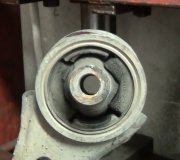I should add that many alignment shops refuse to align vehicles with mismatched tires because they know there will be customer complaints afterward due to tire pull. You can sit on a chair with legs of different lengths but it won't be pleasant. You can align a car that isn't sitting level, but the numbers will only be correct when it is sitting on a level hoist. It will not address the pull caused by different tires, and the angle changes as the suspension travels up and down over uneven roads.
Besides mismatched tires, weak springs are a bigger reason to not align a vehicle. Ride height is critical to proper handling and tire wear. When the suspension sags, it changes the geometry of the control arm(s) and spindle. To show what I mean, stick your arm straight out to your side. Notice how far away your fingertips are. If you raise your arm up six inches and down six inches, that would mimic your van's suspension going up and down as you peddle down the highway. As you do that, do you see how much closer your fingertips get to your body? Not much change in distance at all. Now, to visualize weak springs, lower your arm halfway down, then move it up and down six inches again. Now you can see because of the arc, your fingertips are moving a lot closer to your legs and further away. That is what happens to the bottom of a tire as the car goes up and down. The alignment numbers can be perfect, but you will still have terrible tire wear from it scrubbing sideways on the road surface. It will also be tilting back and forth causing it to run on the edges a lot. That will increase inside and outside wear.
A five year old van should not be suffering from weak springs yet but a conscientious alignment specialist will still measure ride height. Ford has always been notorious for not providing some alignment adjustments, especially on their front-wheel-drive cars, so ride height is particularly important. Some of their cars have extremely bad tire wear built in that can not be corrected. The '80s models Escorts are perfect examples. The front tires tilt out on top so much that it looks like something is broken, and there is no way to adjust it. It made them ride real smooth compared to other brands of small cars so they sold a pile of them, but you had to be pretty lucky to get more than 15,000 miles out of a set of tires. Got'cha! The alignment industry came up with some modifications that would correct the rear tires from being tipped in way too much but due to the design of the front suspension, there was nothing that could be done on the front except keep buying tires.
Caradiodoc
Tuesday, November 23rd, 2010 AT 7:28 PM


